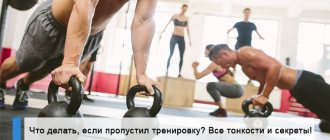How much rest do you need between workouts? This is perhaps one of the most important issues in strength sports and bodybuilding. The reason is obvious - it has to do with rest and recovery. And 80% of the result depends on them. Most people are convinced that the most important thing is to regularly visit the gym. But it is not always the case. You could even say that rest is more important than the workout itself. If you've been training hard for the past few months without any noticeable results, then your problem is most likely recovery. There may be several reasons why you cannot achieve the desired result:
- The weights are too small.
- Performing ineffective exercises.
Most likely there are others. But, if the muscles receive enough stimulus to grow and do not grow, then the problem lies precisely in rest. This most often happens to those who are trying to gain muscle mass and burn fat at the same time. It is much more difficult for them to recover due to a lack of calories. Another situation is that some people strictly adhere to proper nutrition, avoid “harmful” foods, and often limit themselves too much. So why are there no results? Are you exercising too much? How many days should you rest between workouts from a sports science perspective?
What is recovery
Recovery is a general term used by athletes to describe the time after exercise. Basically, this is what our body does in order to return to normal after exercise. However, no matter what you do, even if you take sports supplements, the body needs some time of inactivity. It's just human physiology. You can neglect it for a while, but pretty soon overtraining will catch up with you. Here are some of the processes that occur in the body during recovery:
- Removal of metabolic end products (lactic acid).
- Restoration of intramuscular pH.
- Replenishing phosphagens so the body can restore ATP (the primary fuel for muscles).
- Restoring the balance of sodium and potassium in muscle cells.
This is our body's natural response to muscle damage and fatigue that occurs during exercise. In fact, recovery can be called repair of the body.
The pain does not subside when moving
You've probably noticed that sometimes muscle pain gradually subsides with simple movements. After waking up, the muscles seem frozen and hard. However, after walking, the pain gradually goes away, and over time the movements become easy and familiar. But if the movements do not have such a positive effect, then this is a clear sign that you have overdone the training.
The nutritionist named the main mistake of those losing weight, it’s not nutrition, but stress
The pan needs to be heated thoroughly. Secrets of crust on fried potatoes
Summer life hack: making comfortable rubber sandals from an old tire
What is a day of rest
First, there are complete rest days in which you do absolutely no training. Secondly, you need to give several days of rest to certain muscle groups so that they rest between loads. For example, on Monday you did a chest workout, and on Tuesday you did a back workout. That's right. But if you trained your legs on Monday, then it will be too much to load them on Tuesday. Therefore, when it comes to rest, this question needs to be divided into two:
- How many full days of rest per week?
- How many rest days between training individual muscle groups?
Getting out of bed makes you want to scream
We all know the feeling when you just don’t want to get out of bed, but if at the same time you also find it difficult to sit down and get in, then this is direct evidence that the body needs rest. In order to simplify this period and make it less painful, you need to pay attention to massage and light stretching exercises.
I turn chocolate and berries into greeting cards (instructions)
Friends began corresponding at a young age: the meeting took place 42 years later
Lonely men should put a photo without a cat on their avatar
How many rest days between workouts?
This is determined by the intensity of the load. Intensity means lifting enough weight to stimulate muscle growth. It is necessary to activate fast-twitch type II muscle fibers through the selection of the right exercises and weights. Muscle recovery depends on two factors:
- Duration of rest.
- Genetics.
Let's say you had a hard leg workout: you did the required amount of exercises, gradually increased the weight (load progression) and came as close as possible to muscle failure in the last approaches. In general, a load that should provide enough stimulation for muscle growth. The question arises: “After how many days can I train my legs again?”
This thing is purely individual. However, all studies agree on one thing: it takes 48 to 72 hours for muscles to fully recover.
In other words, you need to recover at least 2-3 days between training individual muscle groups. However, the duration of recovery also depends on how long you have been exercising. Beginners need less time than experienced athletes. Also, the duration of recovery depends on gender, as men take longer than women. This is due to the fact that men have more muscle mass. Beginner or experienced athlete, man or woman, in any case, at least 2 days of rest are required between loads of individual large muscle groups. This means that if you train on Tuesday, your next leg workout should be on Friday. As in the antagonist muscle training program:
- Monday - chest, back, triceps.
- Tuesday - legs, shoulders, biceps.
- Thursday - chest, back, triceps.
- Friday - legs, shoulders, biceps.
- Wednesday, Saturday and Sunday - rest.
The legs are the largest muscles in the body, you're dealing with powerful quadriceps, hamstrings, and glutes. Research shows that the larger the muscle group, the longer it takes to recover. This is absolutely logical. For example, almost every exercise uses your arms, but it is rare to overtrain them. The bottom line is that muscle mass in the arms is much less than in any other area of the body. Therefore, they need less time to recover. What happens if you rest longer? Here is an example of a popular 5-day training program:
- Monday - chest.
- Tuesday - back.
- Wednesday - hands.
- Thursday - legs.
- Friday - shoulders.
- Saturday, Sunday - rest.
Only 2 days off a week, but all major muscle groups are trained only 1 time. This means there will be 6 days of rest between leg workouts. If your strength training is really heavy, then you can achieve great results with this program. The best way to determine your maximum rest period is to rest a muscle group longer than usual. For example, 7 days. And then check whether the strength has increased. If the strength has increased, then give it a rest for 8-9 days. Sometimes this period can be 12-14 days before the strength begins to decrease. People who exercise regularly can maintain their strength levels for a long time.
Experienced athletes can maintain their strength levels for a long time by training just once a week.
This is why a 5-day split is quite effective. Although you train each muscle group only once every 6 days, you actually train 5 days a week. In this case, 6 days of rest between workouts for each muscle group allows you to achieve significant progress. In addition, you are much less likely to drive yourself into a state of overtraining than when performing fullbody or CrossFit training more than 2 times a week. Even full body training 3 times a week ( with 4 days of rest ) will have a much worse effect on the body than working out one muscle group 1-2 times a week ( with 2 days of rest ). Again, it all comes down to how many days you give each individual muscle group to rest. And it’s not so important how many full days of rest you give yourself. At a minimum, a break of 2-3 days between loads for each muscle group.
HOW LONG DOES MUSCLE RECOVER AFTER TRAINING?
Bogdashkin Nikita
Apr 20, 2020 · 6 min read
Almost all athletes once started with a similar mistake - working hard with weights and minimal rest. And only later does the realization come that you need to be able not only to train hard, but also to rest properly.
How muscles react to high load
Effective training is the kind of work that causes the body to experience stress. This happens because through heavy physical exercise we remove the body from its favorite state of comfort, and therefore it turns on its protective reflex - a recovery process with a subsequent increase in strength and overall endurance. The same process is also triggered as a result of damage to muscle fibers, which we mercilessly injure during strength training with heavy weights. That is, the muscle response to high load is stress followed by recovery. And with each such process, the muscles become larger and stronger. That is, muscle growth does not occur during the training itself, but during proper rest from physical activity. To understand how long it will take to restore microtraumas to muscle tissue and, accordingly, increase strength and muscles, you need to understand how the process itself occurs.
It is also worth listing which hormones are vital in fiber restoration:
Insulin – regulates the flow of glucose into muscle tissue;
testosterone is the main stimulator of protein synthesis;
growth hormone – promotes muscle hypertrophy and, accordingly, their increase.
How muscle tissue is restored
It should be understood that the recovery process includes separate stages, and muscle growth depends on the duration of each of them:
Hemostasis is an initial healing step initiated by the body to stop blood and other fluids from leaking out as a result of muscle tissue damage. At the same time, many thin membranes are formed around the injured area of tissue for the same purpose - to stop bleeding, which is a completely expected reaction of the body in relation to any injuries and damage. Add a description
Filling the gap. At first, the gap formed between the two edges of the wound is filled with blood, lymph and other body fluids, but after a certain time new tissue is formed in this space. However, at first this type of tissue differs from permanent muscles due to the lack of normal blood circulation. Add a description
Reducing the gap. Around this stage, muscle pain subsides, and the athlete has the impression of complete recovery, but this is not the case. In reality, in the rupture the type of tissue changes to a more durable one, and the edges of the wounds are sealed. But still, even this stage cannot be regarded as complete muscle recovery. But, nevertheless, the area of damaged tissue areas is noticeably reduced. Add a description
Restoring the original fabric type. The body begins to return to the original type of tissue only after the damaged areas are completely minimized, plus it starts the process of formation of new tendons and ligaments. At this stage, the restoration can be considered complete. Add a description
The time allocated for this multi-stage process is a purely individual indicator, and it is impossible to determine exactly how many days the muscles of different athletes will need to recover. But in general, determining the period after which the muscles after training are fully recovered and ready for the next load is an important factor for proper muscle building.
What biological processes are involved in the recovery process?
Intense physical activity provokes rupture of muscle tissue, and therefore biological processes such as:
Regeneration of muscle fibers - that is, not just restoration, but also strengthening compared to their previous state.
Restoring lost fluid in muscles. As already mentioned, after injury, the rupture site fills with body fluids, for which it is important to maintain a sufficient amount of fluid in general. That is why drinking pure water is a must when gaining muscle mass.
Accelerated protein synthesis. In particular, training in the gym increases the synthesis of protein compounds by at least 50%, which is required to strengthen the muscles and increase their ability to withstand greater stress. That is, proper growth of muscle mass is possible only if the rate of protein synthesis confidently exceeds the intensity of catabolic processes.
The listed processes are the basis of muscle building, so every athlete should take rest outside the gym as seriously as strength training.
Popular myths about muscle performance and recovery
No pain - no result. This statement is only partly true. A common mistake newbies make is failing to differentiate between mild or intense muscle burning sensations and crippling muscle, bone, and joint pain, which are more likely a sign of overtraining rather than “great performance.” Therefore, if excruciating pain in the body appears after each workout, this is a sure signal that you periodically need to either reduce it or, conversely, increase it. You should also recalculate your diet for calories to make sure you are not deficient.
Bed rest on rest days. This myth exists more often among beginners who work hard to strengthen muscles rather than to increase overall mass, and that is why on rest days they are sometimes even panicky about spending even a minimal amount of valuable calories. In fact, increasing blood circulation helps reduce recovery time, so instead of sleeping and lying down, it is more beneficial to do light cardio training in the style of “warming up”, but not fat burning.
Split is more effective than full body training. This myth was refuted after a study was conducted in 2020, when they compared the results of athletes who divided the program into splits of 3 days a week, and athletes who preferred complex training for all muscles of the body, also 3 days a week. The best results were shown by the latter, even by those athletes who divided their training into upper and lower body.
Optimal training time in the gym
We have all heard many times that muscles need at least 48 hours after training to fully recover, and for large groups this period can reach up to 72 hours. All this is true, but the problem is that uninitiated athletes take this recommendation literally, and plan training with precise frequency on clearly defined days. In reality, before the athlete’s muscles become stronger and their own sports immunity is developed, as well as a more permanent regime is formed, the frequency of training and rest days should be determined experimentally. At first, you shouldn’t get hung up on specific training days and schedule classes for specific days of the week, because if your muscles are still sore after training on Monday, then you shouldn’t strive for new loads on Wednesday just because that day is indicated in your diary. It is necessary to allow the muscles to fully recover. By the way, it has been proven that after complete recovery there comes a period of supercompensation - the so-called “window of opportunity” before the muscles begin to wean themselves from physical activity and atrophy. Classes during this period guarantee more productive training with full dedication.
Also, some of the controversy concerns the duration of the workout. Most athletes adhere to standard recommendations to include physical activity in a 60-minute workout, and no more than 15–20 minutes for pre-warm-up and post-training stretching. Although in some cases athletes spend 2 hours doing hard work in their favorite gym. It is important to understand the essence here - you need to train as much as possible to avoid overtraining, which can easily throw any athlete off track for an indefinite period. If the strength and energy allows you to train for more than an hour without compromising your results, no one stops you. Moreover, now there are a lot of means to speed up and facilitate muscle healing during the rest period.
How to speed up muscle recovery
Everyone goes through muscle pain, this feeling is especially unusual for beginners. But good muscle training cannot do without discomfort during the recovery period. If this cannot be avoided, then recovery can be facilitated and accelerated. Here are some tips that work for everyone - from beginners to the most advanced athletes:
Get used to a full warm-up (all muscles and joints of the body) from the very first days in the gym. Even if the first workouts are carried out with ridiculous weights, stretching should always take at least 10 minutes at the beginning of the training.
Make it a habit to spend at least 10-15 minutes stretching after finishing your workout. It is in vain that many athletes neglect stretching, because stretching a muscle gives it more flexibility and relieves tension.
Periodically practice myofascial massage, which can also effectively relieve muscle tension. Relaxed muscles recover faster.
Drink enough water. Pure drinking water promotes the rapid removal of lactic acid from muscles, which is always formed during heavy training, plus it promotes faster transport of amino acids to muscle fibers. This is especially important after hard work in the gym, when we lose most of the fluid from the body through sweat.
Periodically take your body out of its “comfort zone.” This should be done at the end of the workout, adding even more stress at the end of a good job. For example, instead of the usual shower, periodically change your schedule and go to the sauna, and then, for example, cool off in the pool. Thus, we force the body to “hurry up” in terms of accelerating recovery processes in order to prepare for a new possible portion of stress.
Provide your muscles with enough amino acids. This is the most banal of advice, which is most often not taken seriously. It was already mentioned above that protein synthesis must precede the breakdown of muscle fibers, and therefore it is important to constantly feed them with amino acids. If you suspect that you are not getting enough of them from regular food, make it a rule to take them in the form of sports supplements before and after workouts. It’s better to drink it in the form of soluble powders.
In general, you should listen to your body and not ignore its signals. Knowing its features, you can competently create a training schedule, a nutrition plan, and a rest regime.
Do you need to rest longer as you age?
A common misconception is that the older we get, the longer it takes for muscles to recover. However, this is not true. The truth is that the results of many studies on this matter are contradictory. Again, everything is individual. A 40 year old who is completely out of shape will take much longer than a 40 year old who exercises regularly. And at forty years old, a person can recover as quickly as a 20-year-old, and in some cases, with good genetics, even faster. It all comes down to how regularly and consistently a person exercises.
Useful conclusions
If you started reading right from the end, here is a summary of the article. How many rest days between workouts do you need? This depends on various factors:
- How intensely do you train?
- How competently do you carry out your recovery? In order for muscles to grow, it is necessary to give 2-3 days of rest between training the main muscle groups. However, this does not mean that more time may not be needed. For example, with a 5-day workout, you could give each muscle group 6 full days of rest and still make great progress.
- What we haven't discussed are supplements that can speed up recovery:
- creatine
- Whey Protein
- omega-3 fatty acids.
Finding the ideal number of rest days between workouts will require some experimentation.
If anything, this article should point you in the right direction. Good luck
How to understand: when and how often?
Everything here is very subjective. If you're already very tired in general and have no desire to do any kind of workout, then it looks like it's time to rest. It’s also time to rest if you have accumulated a lot of injuries and your whole body constantly hurts. Moreover, this is not muscle pain.
How often? Personally, I rest 1 month a year. That is, once a year. You can also rest once every six months or even once every 3-4 months. But not more often. That is, approximately 1 – 2 times a year. Well, fanatics can do it once every 2 years. In general, something like this.










